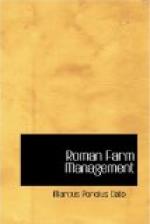“Mix all together on the salting table. Then rub each ham with this mixture, and, in packing, spread some of it on each layer of ham. Use no more salt than has been mixed. Pack skin down and let stand for five weeks, then hang in the smoke house for five or six weeks, and smoke in damp weather, using hickory wood.
“As a ham, however well cured, is of no use to civilized man until it is cooked, and as this crowning mystery is seldom revealed out of Virginia, it may not be out of place to record here the process.”
A VIRGINIA RECIPE FOR COOKING HAMS
Soak over night in cold water, having first scrubbed the ham with a small brush to remove all the pepper, saltpetre, etc., left from the curing process.
Put on to boil next morning in tepid water, skin downwards, letting it simmer on back of stove, never to boil hard. This takes about four hours (or until it is done, when the ham is supposed to turn over, skin upwards, of its own accord, as it will if the boiler is large enough). Set aside over another night in the water it has boiled in.
The following day, skin and bake in the oven, having covered the ham well with brown sugar, basting at intervals with cider. When it is well baked, take it out of the oven and baste another ten to twenty minutes in the pan on top of the stove. The sugar crust should be quite brown and crisp when done.
To be thoroughly appreciated a ham should be carved on the table, by a pretty woman. A thick slice of ham is a crime against good breeding.]
[Footnote 42: It is interesting that Varro has realized the hope, here expressed, that his wisdom might survive for the benefit of the “uttermost generations of men” chiefly in the case of this treatise on Husbandry among the many monuments of his industry and learning. Petrarch in his Epistle to Varro in that first delightful book of Letters to Dead Authors (de rebus familiaribus XXIV, 6) rehearses the loss of Varro’s books and, adapting the thought here expressed in the text, regrets for that reason that Varro cannot be included in that company of men “whom we love even after their death owing to the good and righteous deeds that live after them, men who mold our character by their teaching and comfort us by their example, when the rest of mankind offends both our eyes and our nostrils; men who, though they have gone hence to the common abode of all (as Plautus says in Casina), nevertheless continue to be of service to the living.” If Petrarch had been a farmer he might have saved some of his regret, for Varro is surely, by virtue of the Rerum Rusticarum, a member of the fellowship Petrarch describes.]
[Footnote 43: Varro was essentially an antiquary and it is amusing to observe that he is unable to suppress his learning even in his prayers. One is reminded of the anecdote of the New England minister, who, in the course of an unctuous prayer, proclaimed, with magisterial authority, “Paradoxical as it may appear, O Lord, it is nevertheless true, etc.”]




